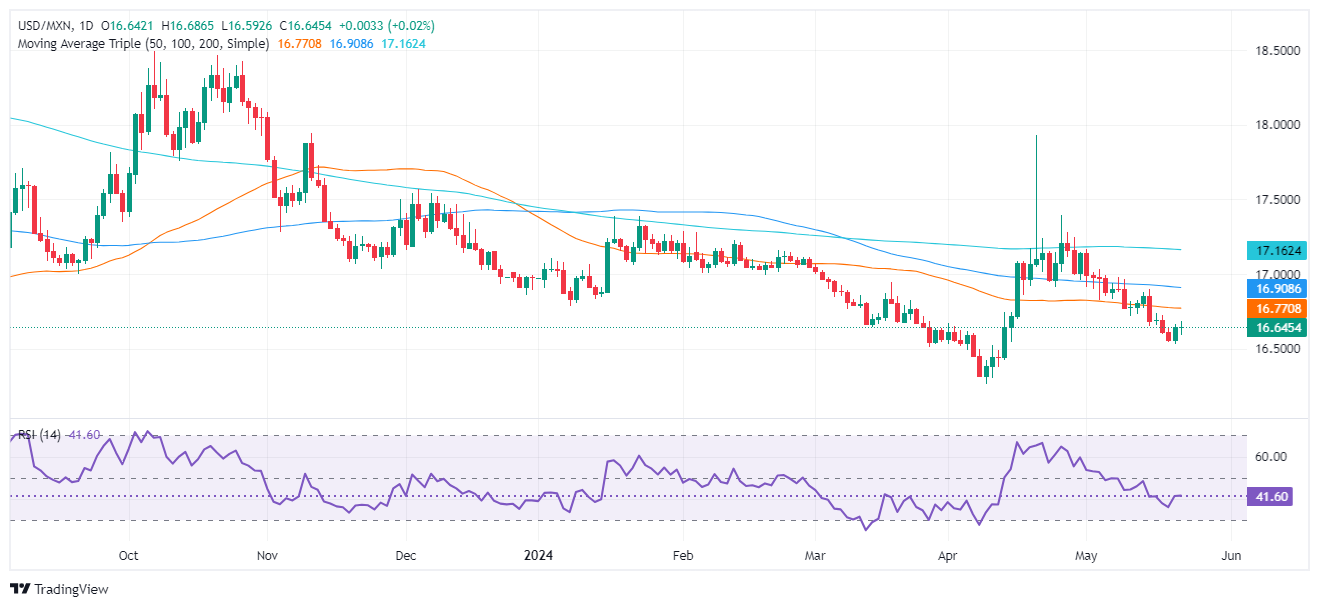- Mexican Peso registers losses as USD/MXN trades at 16.68, up more than 0.30%.
- Federal Reserve meeting minutes showed that officials could raise rates if inflation warrants it.
- The Citibanamex survey shows most analysts expect a Banxico rate cut on June 27.
The Mexican Peso registers losses against the US Dollar on Wednesday during the North American session after the minutes of the last Federal Reserve (Fed) monetary policy meeting were released. That and recent Fed officials' hawkish commentary kept the Peso down on the week. The USD/MXN trades at 16.68, up 0.31%.
The latest Federal Open Market Committee minutes highlighted, "Various participants mentioned willingness to tighten policy further should risks to outlook materialize and make such action appropriate.” Regarding the tightness of the monetary policy, officials remained uncertain, adding that “it would take longer than previously anticipated to gain greater confidence in inflation moving sustainably to 2%.”
During the week, speeches by Federal Reserve officials laid the ground for the “hawkish tilt” of the FOMC’s minutes, as most officials commented they would like to be certain that inflation is edging down and that they’re not in a rush to lower the federal funds rate.
Across the border, the May Citibanamex survey showed that 26 analysts estimate the Bank of Mexico (Banxico) will lower rates at the upcoming meeting on June 27. Eight estimate the Mexican central bank will lower rates until the second half of 2024.
Inflation expectations for 2024 were revised upward from 4.17% to 4.21%, while underlying prices are expected to fall from 4.10% to 4.07%.
Daily digest market movers: Mexican Peso drops on strong US Dollar after Fed minutes
- On Tuesday, Mexico’s docket featured the Economic Activity Indicator for April, which revealed that the economy slowed, according to non-seasonally adjusted figures on a yearly basis.
- On Thursday, Mexico’s economic docket will feature the announcement of the Gross Domestic Product for Q1 2024 and mid-month inflation data for May. Banxico will also reveal monetary policy minutes from its latest meeting.
- Mexico’s Gross Domestic Product for Q1 2024 is expected to show the Mexican economy is slowing amid higher borrowing costs of 11.00% set by Banxico due to fears of higher inflation and the risks of Peso depreciation.
- Diverging views surfaced in Banxico. Governor Victoria Rodriguez Ceja said last Monday that the bank would discuss lowering rates in the upcoming meeting on June 29. Conversely, Deputy Governor Espinosa commented that lowering rates in March might have delayed inflation convergence toward the central bank’s target by two quarters.
- On Tuesday, Fed officials made some comments. Atlanta Fed President Raphael Bostic said he isn’t in a hurry to reduce rates and prefers to keep them steady. Later, Fed Governor Christopher Waller said that April’s CPI showed progress but that he needs to see several months of good inflation data before supporting a rate cut. His colleague, Vice-Chair of Supervision Michael Barr, commented, “We still need to finish the job on inflation.”
- Data from the Chicago Board of Trade shows investors are expecting 31 basis points (bps) of Fed easing toward the end of the year.
Technical analysis: Mexican Peso on the defensive as USD/MXN hovers near 16.70
The USD/MXN remains in a downtrend, though it seems to have bottomed out at around the 16.52/54 area during the week. The exotic pair has broken the 16.60 resistance level. Sellers’ momentum stalled as depicted by the Relative Strength Index (RSI), which stands in bullish territory but flat.
If buyers lift the USD/MXN toward the 50-day Simple Moving Average (SMA) at 16.76, it could exacerbate a rally toward the 100-day SMA at 16.91. Once cleared, the next supply zone would be the 17.00 psychological level. In that event, the next stop would be the 200-day SMA at 17.17.
Conversely, a drop below 16.52 could exacerbate a challenge of the 16.50 psychological level, ahead of the year-to-date low of 16.25.
Mexican Peso FAQs
The Mexican Peso (MXN) is the most traded currency among its Latin American peers. Its value is broadly determined by the performance of the Mexican economy, the country’s central bank’s policy, the amount of foreign investment in the country and even the levels of remittances sent by Mexicans who live abroad, particularly in the United States. Geopolitical trends can also move MXN: for example, the process of nearshoring – or the decision by some firms to relocate manufacturing capacity and supply chains closer to their home countries – is also seen as a catalyst for the Mexican currency as the country is considered a key manufacturing hub in the American continent. Another catalyst for MXN is Oil prices as Mexico is a key exporter of the commodity.
The main objective of Mexico’s central bank, also known as Banxico, is to maintain inflation at low and stable levels (at or close to its target of 3%, the midpoint in a tolerance band of between 2% and 4%). To this end, the bank sets an appropriate level of interest rates. When inflation is too high, Banxico will attempt to tame it by raising interest rates, making it more expensive for households and businesses to borrow money, thus cooling demand and the overall economy. Higher interest rates are generally positive for the Mexican Peso (MXN) as they lead to higher yields, making the country a more attractive place for investors. On the contrary, lower interest rates tend to weaken MXN.
Macroeconomic data releases are key to assess the state of the economy and can have an impact on the Mexican Peso (MXN) valuation. A strong Mexican economy, based on high economic growth, low unemployment and high confidence is good for MXN. Not only does it attract more foreign investment but it may encourage the Bank of Mexico (Banxico) to increase interest rates, particularly if this strength comes together with elevated inflation. However, if economic data is weak, MXN is likely to depreciate.
As an emerging-market currency, the Mexican Peso (MXN) tends to strive during risk-on periods, or when investors perceive that broader market risks are low and thus are eager to engage with investments that carry a higher risk. Conversely, MXN tends to weaken at times of market turbulence or economic uncertainty as investors tend to sell higher-risk assets and flee to the more-stable safe havens.
Information on these pages contains forward-looking statements that involve risks and uncertainties. Markets and instruments profiled on this page are for informational purposes only and should not in any way come across as a recommendation to buy or sell in these assets. You should do your own thorough research before making any investment decisions. FXStreet does not in any way guarantee that this information is free from mistakes, errors, or material misstatements. It also does not guarantee that this information is of a timely nature. Investing in Open Markets involves a great deal of risk, including the loss of all or a portion of your investment, as well as emotional distress. All risks, losses and costs associated with investing, including total loss of principal, are your responsibility. The views and opinions expressed in this article are those of the authors and do not necessarily reflect the official policy or position of FXStreet nor its advertisers. The author will not be held responsible for information that is found at the end of links posted on this page.
If not otherwise explicitly mentioned in the body of the article, at the time of writing, the author has no position in any stock mentioned in this article and no business relationship with any company mentioned. The author has not received compensation for writing this article, other than from FXStreet.
FXStreet and the author do not provide personalized recommendations. The author makes no representations as to the accuracy, completeness, or suitability of this information. FXStreet and the author will not be liable for any errors, omissions or any losses, injuries or damages arising from this information and its display or use. Errors and omissions excepted.
The author and FXStreet are not registered investment advisors and nothing in this article is intended to be investment advice.
Recommended content
Editors’ Picks

AUD/USD holds steady near 0.6250 ahead of RBA Minutes
The AUD/USD pair trades on a flat note around 0.6250 during the early Asian session on Monday. Traders brace for the Reserve Bank of Australia Minutes released on Monday for some insight into the interest rate outlook.

USD/JPY consolidates around 156.50 area; bullish bias remains
USD/JPY holds steady around the mid-156.00s at the start of a new week and for now, seems to have stalled a modest pullback from the 158.00 neighborhood, or over a five-month top touched on Friday. Doubts over when the BoJ could hike rates again and a positive risk tone undermine the safe-haven JPY.

Gold: Is another record-setting year in the books in 2025?
Gold benefited from escalating geopolitical tensions and the global shift toward a looser monetary policy environment throughout 2024, setting a new all-time high at $2,790 and rising around 25% for the year.

Week ahead: No festive cheer for the markets after hawkish Fed
US and Japanese data in focus as markets wind down for Christmas. Gold and stocks bruised by Fed, but can the US dollar extend its gains? Risk of volatility amid thin trading and Treasury auctions.

Bank of England stays on hold, but a dovish front is building
Bank of England rates were maintained at 4.75% today, in line with expectations. However, the 6-3 vote split sent a moderately dovish signal to markets, prompting some dovish repricing and a weaker pound. We remain more dovish than market pricing for 2025.

Best Forex Brokers with Low Spreads
VERIFIED Low spreads are crucial for reducing trading costs. Explore top Forex brokers offering competitive spreads and high leverage. Compare options for EUR/USD, GBP/USD, USD/JPY, and Gold.
